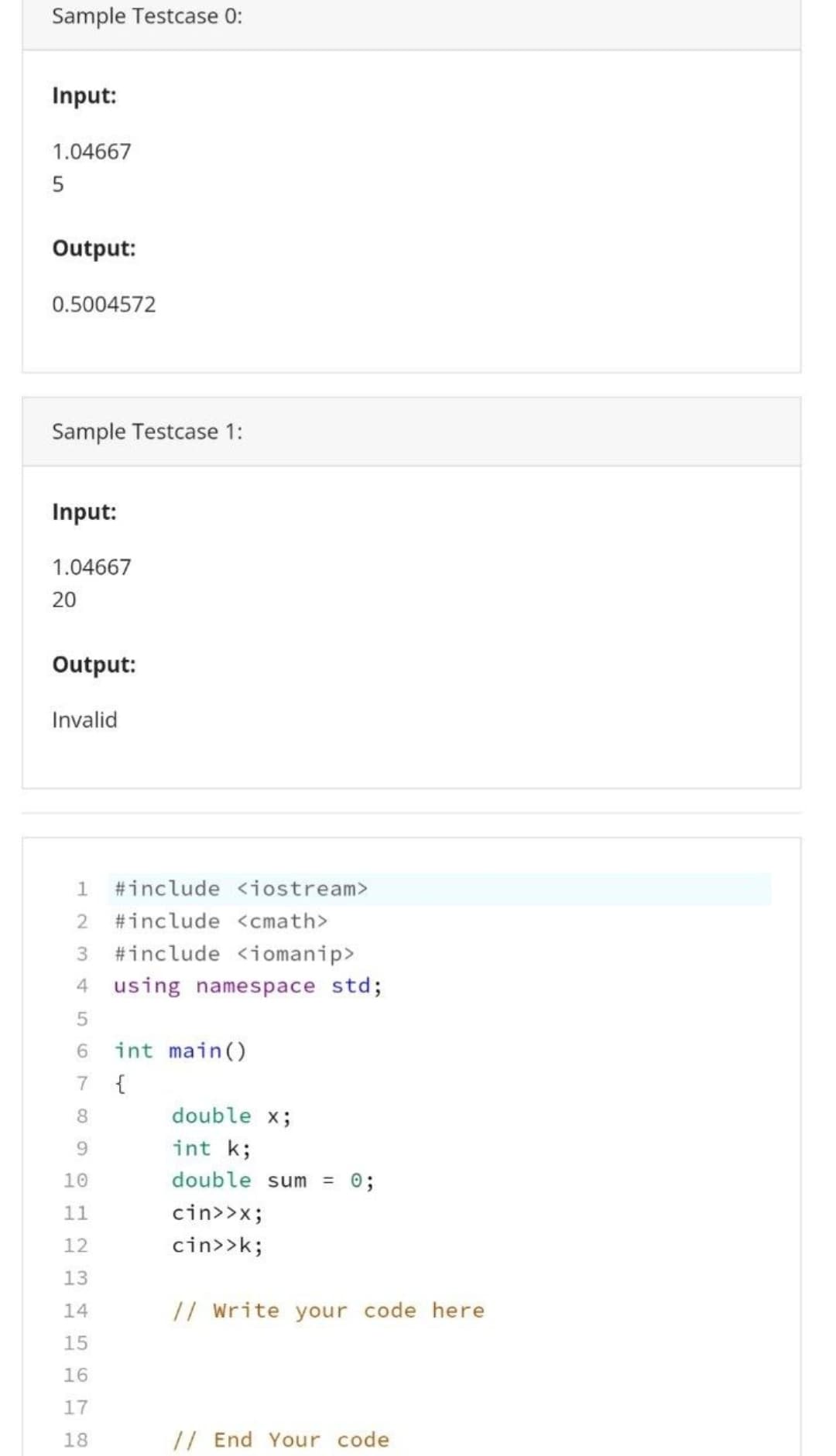In this task, you are required to write a code which takes as an input an angle [0°, 90°] in radians and returns the approximate value of the cosine of this angle. The code will also take as an input the number of terms to be used to approximate the result. We will use the Maclaurin series of cos(x) to approximate the result. The series is given by: cos(x) Σn=0 (2n!) -1" 2n
In this task, you are required to write a code which takes as an input an angle [0°, 90°] in radians and returns the approximate value of the cosine of this angle. The code will also take as an input the number of terms to be used to approximate the result. We will use the Maclaurin series of cos(x) to approximate the result. The series is given by: cos(x) Σn=0 (2n!) -1" 2n
C++ Programming: From Problem Analysis to Program Design
8th Edition
ISBN:9781337102087
Author:D. S. Malik
Publisher:D. S. Malik
Chapter5: Control Structures Ii (repetition)
Section: Chapter Questions
Problem 14PE
Related questions
Question
c+++++++++++++ c
![In this task, you are required to write a code which takes as an input an angle
[0°, 90°] in radians and returns the approximate value of the cosine of this
angle. The code will also take as an input the number of terms to be used to
approximate the result.
We will use the Maclaurin series of cos(x) to approximate the result. The
series is given by:
cos(x)
=
Σn=0
-1"x2n
(2n!)
but for practical reasons, we will not use infinite terms but k terms where k is
input by the user:
cos(x)
=
Σ
-1x2n
2n=0 (2n!)
So, for example, to calculate the cosine for 60° (1.04667 radians) using five
terms, the approximation will be:
1.04667²
1
1.04667¹
4!
1.046676 1.046678
+
0.50046
2!
6!
8!
• The program should at most handle 15 terms (to avoid overflows due
to factorial), otherwise the program outputs Invalid
• There should be at least three terms used in the approximation,
otherwise the program outputs Invalid
• If the number of terms is negative, the programs corrects it
automatically to positive.
• If the angle is out of range, the program outputs Invalid
1/0
Program Input:
A single line that takes in any angle (in radians)
• A single line that takes in the number of terms to use in the
approximation
Program Output:
• A single line that outputs the approximate value of the cosine](/v2/_next/image?url=https%3A%2F%2Fcontent.bartleby.com%2Fqna-images%2Fquestion%2F14aa93be-3d7a-4f58-94cc-382dc4d854bb%2Fec1a0495-3432-4429-8f8c-6b7c0a96be04%2Fv8qcmfh_processed.jpeg&w=3840&q=75)
Transcribed Image Text:In this task, you are required to write a code which takes as an input an angle
[0°, 90°] in radians and returns the approximate value of the cosine of this
angle. The code will also take as an input the number of terms to be used to
approximate the result.
We will use the Maclaurin series of cos(x) to approximate the result. The
series is given by:
cos(x)
=
Σn=0
-1"x2n
(2n!)
but for practical reasons, we will not use infinite terms but k terms where k is
input by the user:
cos(x)
=
Σ
-1x2n
2n=0 (2n!)
So, for example, to calculate the cosine for 60° (1.04667 radians) using five
terms, the approximation will be:
1.04667²
1
1.04667¹
4!
1.046676 1.046678
+
0.50046
2!
6!
8!
• The program should at most handle 15 terms (to avoid overflows due
to factorial), otherwise the program outputs Invalid
• There should be at least three terms used in the approximation,
otherwise the program outputs Invalid
• If the number of terms is negative, the programs corrects it
automatically to positive.
• If the angle is out of range, the program outputs Invalid
1/0
Program Input:
A single line that takes in any angle (in radians)
• A single line that takes in the number of terms to use in the
approximation
Program Output:
• A single line that outputs the approximate value of the cosine

Transcribed Image Text:Sample Testcase 0:
Input:
1.04667
5
Output:
0.5004572
Sample Testcase 1:
Input:
1.04667
20
Output:
Invalid
1 #include <iostream>
2 #include <<math>
3 #include <iomanip>
4 using namespace std;
5
6 int main()
7
{
8
double x;
9
int k;
10
double sum = 0;
11
cin>>x;
12
cin>>k;
13
14
// Write your code here
15
16
17
18
// End Your code
Expert Solution
This question has been solved!
Explore an expertly crafted, step-by-step solution for a thorough understanding of key concepts.
Step by step
Solved in 3 steps with 1 images

Knowledge Booster
Learn more about
Need a deep-dive on the concept behind this application? Look no further. Learn more about this topic, computer-science and related others by exploring similar questions and additional content below.Recommended textbooks for you

C++ Programming: From Problem Analysis to Program…
Computer Science
ISBN:
9781337102087
Author:
D. S. Malik
Publisher:
Cengage Learning

C++ Programming: From Problem Analysis to Program…
Computer Science
ISBN:
9781337102087
Author:
D. S. Malik
Publisher:
Cengage Learning